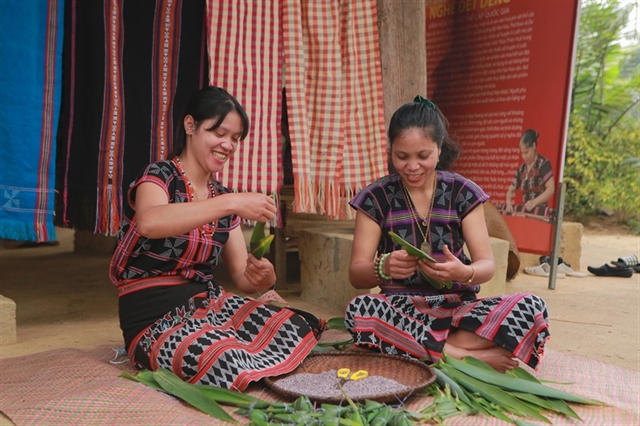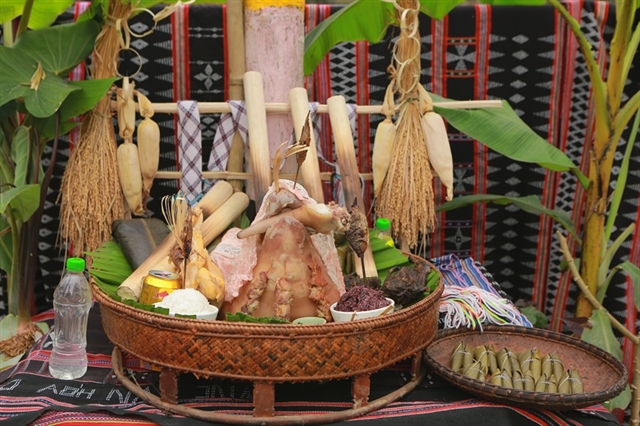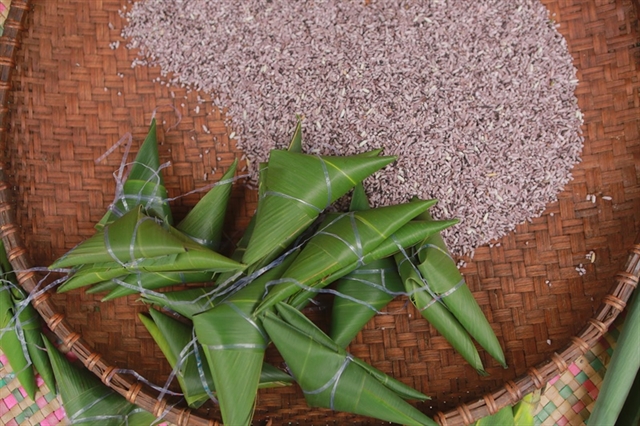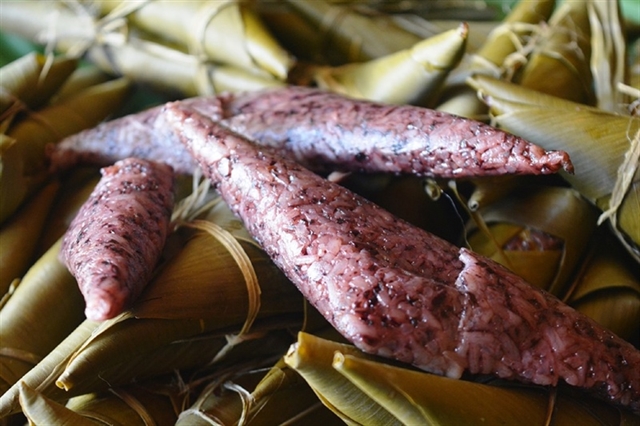Quý Dương
“We are lucky to have a chance to enjoy a special dish (locally known as bánh a quát or loved cake) made by the Tà Ôi ethnic people of A Lưới District of Thừa Thiên-Huế Province,” said Hanoian Nguyễn Thị Bằng.
Bằng said her group recently toured the Việt Nam National Village for Ethnic Culture and Tourism in Đồng Mô, 40km east of Hà Nội, to join Tà Ôi people making the cake.

Two Tà Ôi women making a quát cakes. Photo danviet.vn
Maker Hồ A Đon invited Bằng and her group to join the Aza Tết of the Tà Ôi, which has been redisplayed at the Đồng Mô site.
“Among offerings for worship, a quát cake should never be missing.”
When a Tà Ôi girl gets married, she often makes several a quát cakes to give to her husband’s family as a dowry, said A Đon, adding that when a mother visits her daughter at her in-laws she also brings these cakes as gifts for them.
Almost all Tà Ôi girls are taught how to make the cakes when they are young by their mother or grandmothers, A Đon said.

The Tà Ôi ethnic people place importance in the a quát cakes, among other offerings to worship their ancestors. Photo danviet.vn
She told the story of a legend: long ago, there was a young Tà Ôi man named Ta-tưi who was very intelligent and strong. At the time, local people did not know how to cultivate and raise livestock, so they had a very hard life. Ta-tưi learned ways of growing rice and raising buffaloes from other villages and came back to help the villagers.
The villagers escaped from hunger and some even became rich. Ta-tưi also helped locals to build the village’s communal house, so they could get together to exchange views on village issues.
When Ta-tưi died, God turned him into a very strong buffalo - very useful for the locals. To keep his image, respect and remember him, the Tà Ôi people make a quát cake, the two sides of which look like buffalo horns, to celebrate big anniversaries such as Tết or a new rice crop, A Đon said.
The ingredients to make the cake include black glutinous rice (locally known as nếp than) which has a gentle fragrance and sweet soft flavour.
“We call it Cu-Char or heaven pearl. Our elders said the cake symbolises a faithful and loyal love of the Tà Ôi.

A bamboo basket displaying the special black glutinous rice used to wrap a quát cakes. Photo danviet.vn
The cake is wrapped in fresh forest leaves known as lá đót (thysanolaena latifolia), which should not be too old or too young, otherwise, they might tear. The cake has two tops, representing the buffalo horns.
After being wrapped up the cakes are tied in couples; the larger cake represents a man and the smaller a girl. The cakes are soaked in water for two hours before being boiled, to ensure that they are soft.
The boiled cake has a pinkish-black colour, said A Đon, adding that nowadays the cake is not only made for big holidays such as anniversaries, Tết or wedding parties but also for dear guests visiting the A Lưới mountains.

The attractive violet colour of the a quát cake. Photo danviet.vn
Bằng’s friend Nguyễn Thu Lan, said: “I’ve heard about the cake a long time ago, but not yet has a chance to visit A Lưới to try it. It’s lucky for us that during the visit to Đồng Mô tourism site in Hà Nội, we can make it ourselves and enjoy it on the spot. The cake has a buttery taste and a sweet fragrance. I can feel the flavour, the simple and warm behaviour of the Tà Ôi people, from the cake.”
Quỳnh Ngưm, head of A Lưới District’s Ta-ay Hamlet, said: “Our traditional culinary was wrapping up a quát, which is never lacking at important village festivals and family parties. We placed importance on the habit of making the cake, which has been handed down from our ancestors. The cake helps us to express respect and thankfulness to God who had given us with life and things to eat every day.” VNS
OVietnam